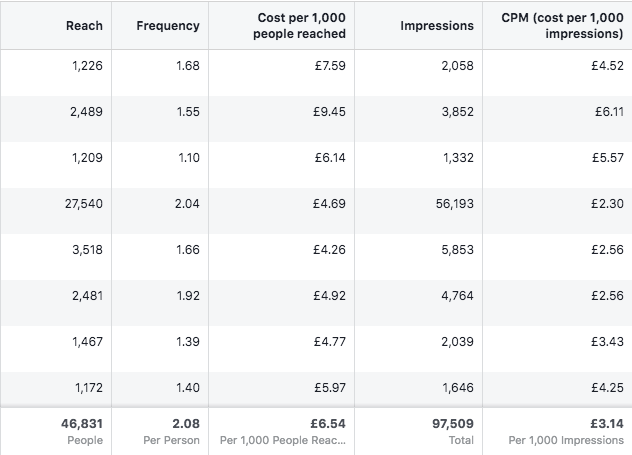The Most Important Facebook Metrics to Track

With so much data available to us, marketers can fall easily foul of data fatigue. On a typical day, you might find yourself obsessing over website traffic, email open rates, Instagram engagement and PPC click-through rates before you’ve even had a chance to finish your morning coffee.
There’s no denying the importance of metrics and data, but without proper analysis, it’s really just noise. To make things worse, it’s never been easier to get distracted by vanity metrics. While these might be prevalent on digital marketing reports, if you’re looking for actionable insight, you’re looking in the wrong place.
What makes a good metric?
In an ideal world, every insight you choose to pay attention to will help to shape future decisions. If the metric does little more than pat you on the back, then it really isn’t going to be helpful.
The first step to navigating the most important Facebook metrics is to sidestep the vanity metrics. These might make you look good, but they aren’t a good indicator of campaign performance.
Stop chasing likes
The biggest vanity metric which has exactly zero impact on campaign performance is page likes. If your sole aim in starting a Facebook campaign is to boost the total number of page likes, you’re wasting your time.
It’s never been easier to buy likes for your Facebook page. Often driven by vanity, brands may choose to boost their Facebook pages metrics with fake likes. While this might have limited positive impact through the trickle-down benefits of social proof, it can also be a death sentence for your page.
If you’ve paid for likes, your audience will likely be made up of dormant Facebook accounts. The owners are never going to log in and check your page – most likely because they don’t have owners. This means a large portion of your followers will never see or interact with your posts, and as a result, Facebook will limit your reach.
There is an honest way of growing your Facebook fan base, but even this can be fruitless. Likes are a vanity metric and should never be your endgame. Simply put, likes won’t keep the lights on in your business.
You can grow a huge following, but if those followers aren’t engaging with your content, you’ve wasted your time, effort and money.
Reach means nothing without context
Another popular vanity metric is reach. If you’ve ever run a paid Facebook campaign and seen your social media department gleefully sharing stats about the campaign reach without further context, you may have fallen victim to another vanity metric.
The reach metric doesn’t tell you anything about the success of your campaign. If you’re seeing a high reach and low engagement rate, this can even be a sign that your campaign wasn’t very successful. You may have reached a large number of people, but you didn't inspire them to act.
Reach alone is a pointless metric, and there is little point in getting excited about it. Instead, you should be focussing on engagement metrics.
Even click-through rates can be misleading
If you aren’t reaching the right people, clicks can be an expensive mistake. And if your Facebook ad message doesn’t match your landing page, you’re simply going to see a high bounce rate.
Looking at the click-through rate in isolation is one of the biggest mistakes marketers can make. So, what else should we consider when heading to Facebook insights? It’s tempting to look at the engagement rate. After all, a handy little percentage figure offers an accessible metric that anyone can understand.
However, that engagement rate can be misleading, too. This metric will not only tell you how many people clicked through to your website, but it will also tell you how many people clicked on your ad image, or “read more” on longer ad copy.
Now that we’ve dismantled some of the vanity metrics that get in the way of progress, we can start to look at what really matters to marketers.
New customers.
The only metrics that should matter to your Facebook marketing strategy are the ones that show you how many new customers your campaign has generated.
Focus on conversions
There’s a reason that conversion rate optimisation has been growing in popularity. If you’re driving a steady stream of traffic to your website and you aren’t seeing any conversions, you have to ask why. You have two choices. Either find a way to drive more traffic to your site, or find a way to make more of the existing traffic convert.

Conversions are ultimately the only thing that matter in a digital marketing campaign.
And conversions can mean lots of different things to different companies. One company might be chasing leads, while another might be more interested in sales. If your customer journey starts by signing up to your newsletter, then this is what you want to see more of.
Increasing the conversion rates for your Facebook advertising should be your only goal. For this reason, accurate conversion tracking on your website is essential. This will allow you to check conversions through Google Analytics, and even assign a monetary value to your conversions.
Avoid annoying people
If you run ads frequently, you’re going to want to avoid annoying people with your presence in their news feed. To manage this, you should keep an eye on your ad frequency. This shows you the number of times your ad has been served to the average user.

If you’re showing your advert to people an average of 10 times and they still aren’t clicking, it’s probably safe to assume they aren’t interested.
If you want to avoid annoying your followers, keeping an eye on your ad frequency is important. If your budget is quite small (under £25 per day) you won’t have to worry about this, but with bigger budgets, keep an eye on your frequency or risk making your audience immune to your advertising.
Find your ideal cost per click
We often hear clients asking what the “ideal” cost per click (CPC) would be. The idea of the perfect cost-per-click is a myth. The factors that influence the cost per click will vary depending on your industry, the type of advert you are running, your budget and your advert creative.
Any attempt to compare two ad campaigns will inevitably be fruitless. Instead, you should look at how much you would be willing to pay for a new lead.
If your conversion rate once users land on your website is an optimistically high 10%, and you drive 1000 clicks to your site at a rate of £0.20 per click, then your cost per acquisition will be £2. If the average order value is under £50, then this cost per acquisition would be worth it. However, if your average order value is in excess of £1000, then a cost per acquisition in excess of £50 would also be worthwhile.
Understanding the cost per acquisition can help you to decide when to call time on a campaign with a high cost-per-click, and when to let it ride.
What about organic Facebook metrics?
So far, we’ve looked at the paid campaign metrics which are valuable to track, but what can organic Facebook stats tell us about the efficacy of our campaigns?
While organic reach on Facebook may be waning, there are stats available that will show you just how effective your Facebook presence is. These are all available in your Facebook analytics, which is known as Facebook Insights.
If you haven’t already, you should update your Facebook page Call-To-Action to ensure it is something helpful. You can then see how many Facebook users are clicking on this prime slice of Facebook page real estate.
Another metric to monitor on your Facebook page is your Like demographics. This can offer valuable insight into the type of content that will be most valuable to your followers. If you post something that leads to a flurry of unlikes, you know you're barking up the wrong tree.
And finally, engagement across post types can help you to laser focus your Facebook strategy.
Everyone knows that video is popular on Facebook, but does it work for your brand?
Putting time and effort into producing video content could be a waste of time if your followers are clicking away after a few seconds. Instead, you should look at engagement metrics beyond video views, including average percentage completion.
Once you know what your followers respond to, you can focus on how to deliver more of the content they love, which will, in turn, generate more link clicks to your website.
Want to create the perfect Facebook report with all these meaningful metrics?
Ready to automate your reporting?
Read More
Don’t miss out!
Automate your reports!
Bring all your marketing data into one automated report.
Try dashthis for free

